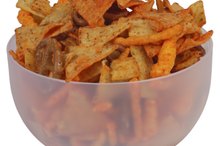What does fact checked mean?
At Healthfully, we strive to deliver objective content that is accurate and up-to-date. Our team periodically reviews articles in order to ensure content quality. The sources cited below consist of evidence from peer-reviewed journals, prominent medical organizations, academic associations, and government data.
- U.S. Food and Drug Administration: Overview of Food Ingredients, Additives and Colors
- U.S. Food and Drug Administration: Questions and Answers on Monosodium Glutamate (MSG)
- Oregon State University: Nitrosamines and Cancer
- World Journal of Gatroenterology: Nitrosamine and Related Food Intake and Gastric and Oesophageal Cancer Risk - A Systematic Review of the Epidemiological Evidence
- World Journal of Gatroenterology: Nitrosamine and Related Food Intake and Gastric and Oesophageal Cancer Risk - A Systematic Review of the Epidemiological Evidence
- MedlinePlus: Chinese Restaurant Syndrome
- Cephalagia: Effect of Systemic Monosodium Glutamate (MSG) on Headache and Pericranial Muscle Sensitivity
- Cephalagia: Effect of Systemic Monosodium Glutamate (MSG) on Headache and Pericranial Muscle Sensitivity
The information contained on this site is for informational purposes only, and should not be used as a substitute for the advice of a professional health care provider. Please check with the appropriate physician regarding health questions and concerns. Although we strive to deliver accurate and up-to-date information, no guarantee to that effect is made.
Sodium Nitrite vs. MSG
Both monosodium glutamate and sodium nitrite are used to flavor and season foods -- and to preserve them as well. Both can be dangerous for you if you eat them in high enough quantities, however. That said, the U.S. Food and Drug Administration considers each to be safe for consumption 123.
Sodium Nitrite Basics
Sodium nitrite gives cured meats their pink color, as it preserves the hue after cooking, as well as acts as an anti-toxin for botulism. Nitrites are present naturally in many vegetables, but preserved meats, such as hot dogs and sausages, contain the highest quantities per serving.
About MSG
Foods That Trigger Ocular Migraines
Learn More
Unlike sodium nitrite, MSG is used primarily as a flavoring agent rather than a preservative. MSG is frequently used in canned foods, processed meats and Chinese food. While there is no limit to the amount of MSG allowed in foods, the FDA requires it to be listed as an ingredient in prepared foods. MSG occurs naturally in foods, where it is called glutamate, but in the early 1900s, it was isolated as a chemical compound by a Japanese scientist.
- Unlike sodium nitrite, MSG is used primarily as a flavoring agent rather than a preservative.
- While there is no limit to the amount of MSG allowed in foods, the FDA requires it to be listed as an ingredient in prepared foods.
How Much to Eat and Side Effects
When consumed in excessive quantities, 22 to 23 milligrams per kilogram of body weight, sodium nitrite is fatal. Sodium nitrite, when it mixes with your stomach acid during digestion, creates nitrosamines. In turn, while there are no limits to how much MSG can be safely consumed, some people claim that they are sensitive to MSG, even in small quantities. This condition is commonly known as Chinese restaurant syndrome because MSG is so frequently used in Chinese fast food, although symptoms may result from eating any foods high in MSG, not just Chinese fast food 6. Symptoms include flushing, numbness, headaches, increased sweating and a swelling feeling in your face.
- When consumed in excessive quantities, 22 to 23 milligrams per kilogram of body weight, sodium nitrite is fatal.
- This condition is commonly known as Chinese restaurant syndrome because MSG is so frequently used in Chinese fast food, although symptoms may result from eating any foods high in MSG, not just Chinese fast food 6.
Other Potential Dangers
List of Foods Containing Tyramine
Learn More
According to Oregon State University, nitrosamines are carcinogenic 4. A 2006 issue of “World Journal of Gastroenterology” included a review of studies over 20 years and concluded that there is a clear association between increased risk of gastric and esophageal cancer and consumption of nitrite and nitrosamines 4. While there are no indications that MSG is carcinogenic, a 2010 issue of “Cephalagia” included a human study which found that consuming high quantities of MSG led to increased incidences of headaches and head muscle tenderness, as well as raised blood pressure levels.
Related Articles
References
- U.S. Food and Drug Administration: Overview of Food Ingredients, Additives and Colors
- U.S. Food and Drug Administration: CFR - Code of Federal Regulations Title 21
- U.S. Food and Drug Administration: Questions and Answers on Monosodium Glutamate (MSG)
- Oregon State University: Nitrosamines and Cancer
- World Journal of Gatroenterology: Nitrosamine and Related Food Intake and Gastric and Oesophageal Cancer Risk - A Systematic Review of the Epidemiological Evidence
- MedlinePlus: Chinese Restaurant Syndrome
- Cephalagia: Effect of Systemic Monosodium Glutamate (MSG) on Headache and Pericranial Muscle Sensitivity
Writer Bio
Lana Billings-Smith has been writing professionally since 1997. She has been published in the "Montreal Gazette" and the "National Post." She also teaches and lectures at McGill University. A certified personal trainer, she holds a Bachelor of Arts with a specialization in leisure sciences and a minor in therapeutic recreation.









